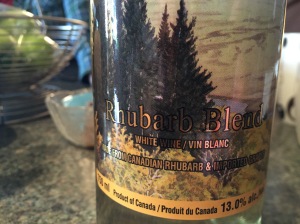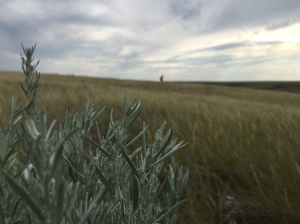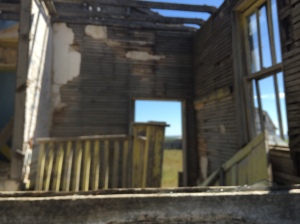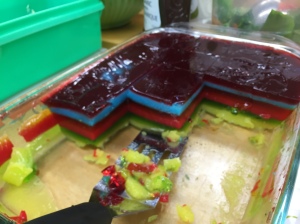Tonight we;re in a grove between caragana hedges, on the Duke farm near Eastend SK. Now that the dark has descended, it feels like a secret, hidden place, with only the sound of cicadas and crickets to accompany my typing. No coyotes as yet, although the moon is full and just waiting for their chorus. The farm is located along the Frenchman River, with the steep walls of the valley rising miles away at either side of a great, wide, flood plain. We walked that plain all day….tawny hills on the left and the right, white mud cliffs that leave your fingers stained, and a river I wanted several times to jump into for some kind of break from the heat. For the first time this trip, we’ve had to contend with mosquitoes, so setting up tents was a hurried affair.
Fortunately, we have a gazebo, and that’s where I shelter to write this. The others have gone to sleep – funny how a full day of walking makes for fatigue as soon as the sun sets. For a late supper we put together Madonna’s lentil soup, Hugh’s beans, Kathryn’s broccoli salad and some British Army ration soup. We ate the resulting mix, out of the pot, with gusto. But the best part of the meal was rhubarb white wine, from the Cypress Hills winery, donated to us by Curt and Lorie Gronhovd, the incredibly kind hosts with whom we stayed last night.
Over dinner (and the wine) we talked about saints and First Nations, about the connection between the Egyptian desert fathers and the Irish monks, and between those monastics and a pilgrimage here and now in south-west Saskatchewan. I guess it’s no mistake that this is, also, a semi-desert that we walk through. Fifteen miles today in land that, like the Biblical wildernesses, reduces the walker to the essentials. When the land is so sparse and the cactus and short grasses (and some cattle skeletons) are all you see, the wind blows and I think of Ezekial calling the four winds at the Lord’s behest, or Christ in the desert. Or Saint-Anthony, seeking white martyrdom in the wilds of Egypt.
Tomorrow we walk to Chimney Coulee, so named for the chimneys left behind by the Métis hivernants who built a settlement there in the mid 1870s. They say there are ghosts there, of the Assiniboine who died scavenging after Cowlie, the Hudson’s Bay trader, hurriedly left in 1873. I guess we’ll find out tomorrow night. For tonight there’s the moon, the mosquitoes, the dark, and the wind through the caraganas. And thoughts of the saints and their time of testing and of encountering the divine in a wilderness not so different from this one.














